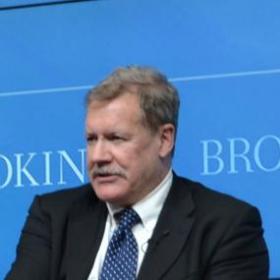
Yellow Sea: The Military Uncertainty
In his weekly column in New Europe, EWI Vice President Greg Austin discusses the heightened U.S. and Japanese military presence in the Yellow Sea in light of the recent conflict between North and South Korea.
The United States and Japan have this past week assembled a naval force that would easily defeat the Chinese navy as it is today. This is the largest joint naval force ever assembled by the two allies. Their forces will be physically concentrated in and around the Sea of Japan, to the west of the country, separating it from Russia and the east coast of the Korean Peninsula. China does not border this sea. For China, the Yellow Sea (sitting between the Korean Peninsula and China), is the more sensitive of the two.
One reason for the joint exercise is to mark the 50th anniversary of the security treaty between the United States and Japan signed in 1960. The military forces have been brought together for an annual exercise called “Keen Sword”. This year’s exercise, unprecedented in scale compared with previous years, was planned well before the most recent attack by North Korea on its southern neighbor on 23 November. The bigger reason why this force is so large however is that North Korea attacked a South Korean navy ship in March, at a time when the North is going through a political transition from the“Dear Leader”, Kim Jong-il to his son, Kim Jong-un, now named “Brilliant Comrade”, who is of course grandson to the “Great Leader”, Kim Il-sung
The “Brilliant Comrade”, not even 30 years old, is already a General of the armed forces and Vice-Chairman of the country’s National Military Commission. His 39-year old half-brother, Kim Jong-nam, who was once heir apparent but now lives in Macao, has reportedly told a Japanese journalist that he opposes dynastic succession.
This political transition in the dictatorship in North Korea, with the armed forces of South Korea on high military alert already because of the recent attack, in a region with the highest concentration of conventional and nuclear military forces anywhere in the world, creates both high uncertainty and high risk that there may be a military miscalculation.
Newspapers in some countries are running reports from experts that war is unlikely. But from a military or political intelligence point of view, that is a nonsensical conclusion. If we know so little about the North’s thinking and since its forces are already on high alert, there is clearly no basis for a judgment that “war is unlikely”. Analysts are interpreting the situation in an indefensible way. They are proceeding from the certainty that “we have seen military provocations in the last three decades by North Korea and they have not led to war” to the conclusion that “a provocation by North Korea can never lead to war”. On this occasion, Vladimir Putin’s assessment is a more reliable one. The situation is “acute and disturbing”.
There is an explicit presumption in much of the commentary, including by Putin, that China has “influence” over North Korea and can restrain it. This is a dangerous assumption. Political influence of one country over another is one of the most mis-understood and over-rated processes in global security affairs, not least in situations of leadership transition and high levels of military mobilization. An assessment of what is likely to happen next must be rooted exclusively in knowledge of the intentions and political dispositions of the “Brilliant Comrade”, the “Dear Leader” and their military forces.
Since so little is known about any of these, then the only prudent response is to stay on military alert until there is an un-mistakable signal of stand-down by North Korea. Since North Korea has only recently revealed the existence of a new nuclear reactor, and it has nuclear weapons, we have to plan for heightened military tensions. The Yellow Sea, very much China’s front yard bordering the Korean peninsula is likely to see heightened military activities in coming months.

